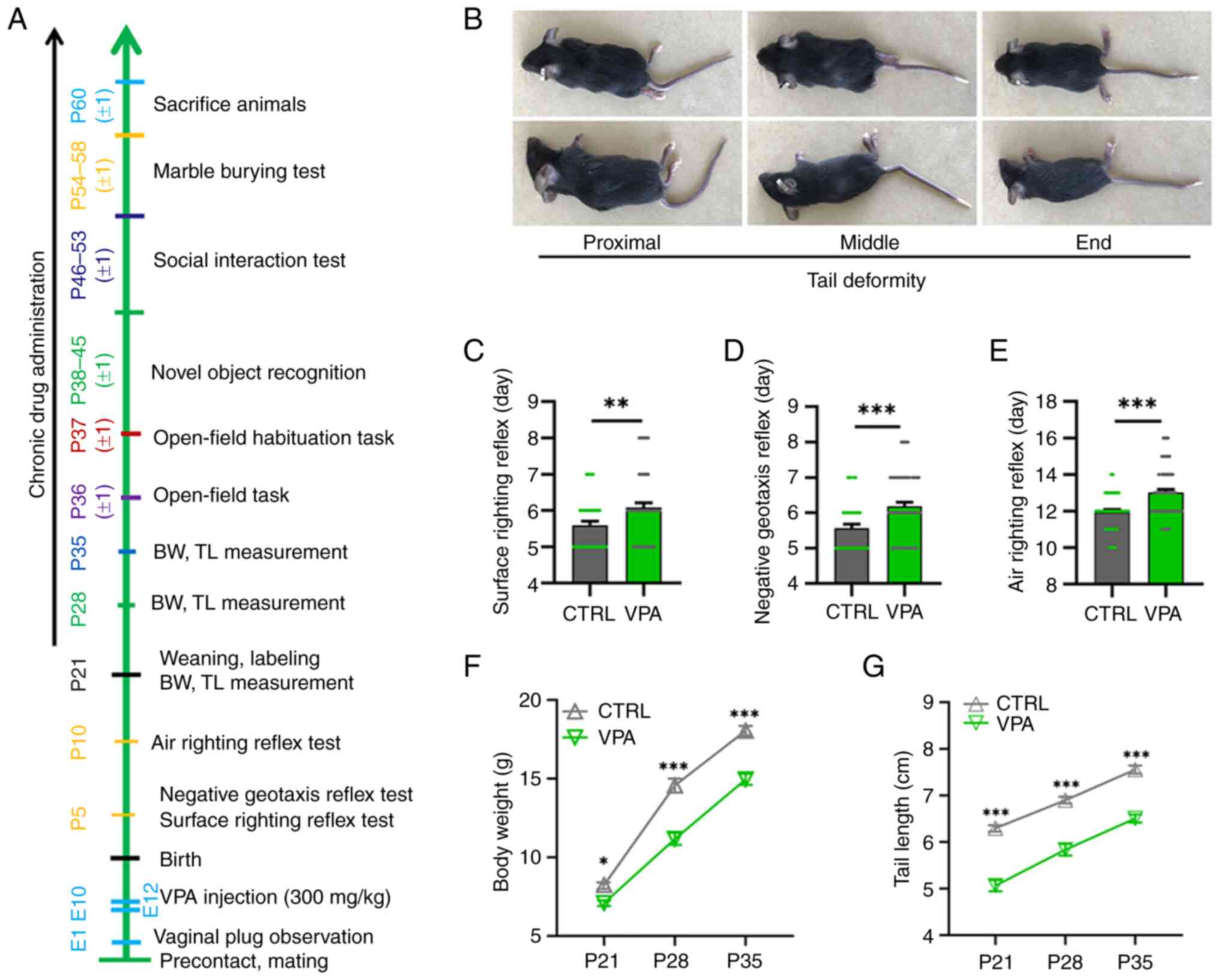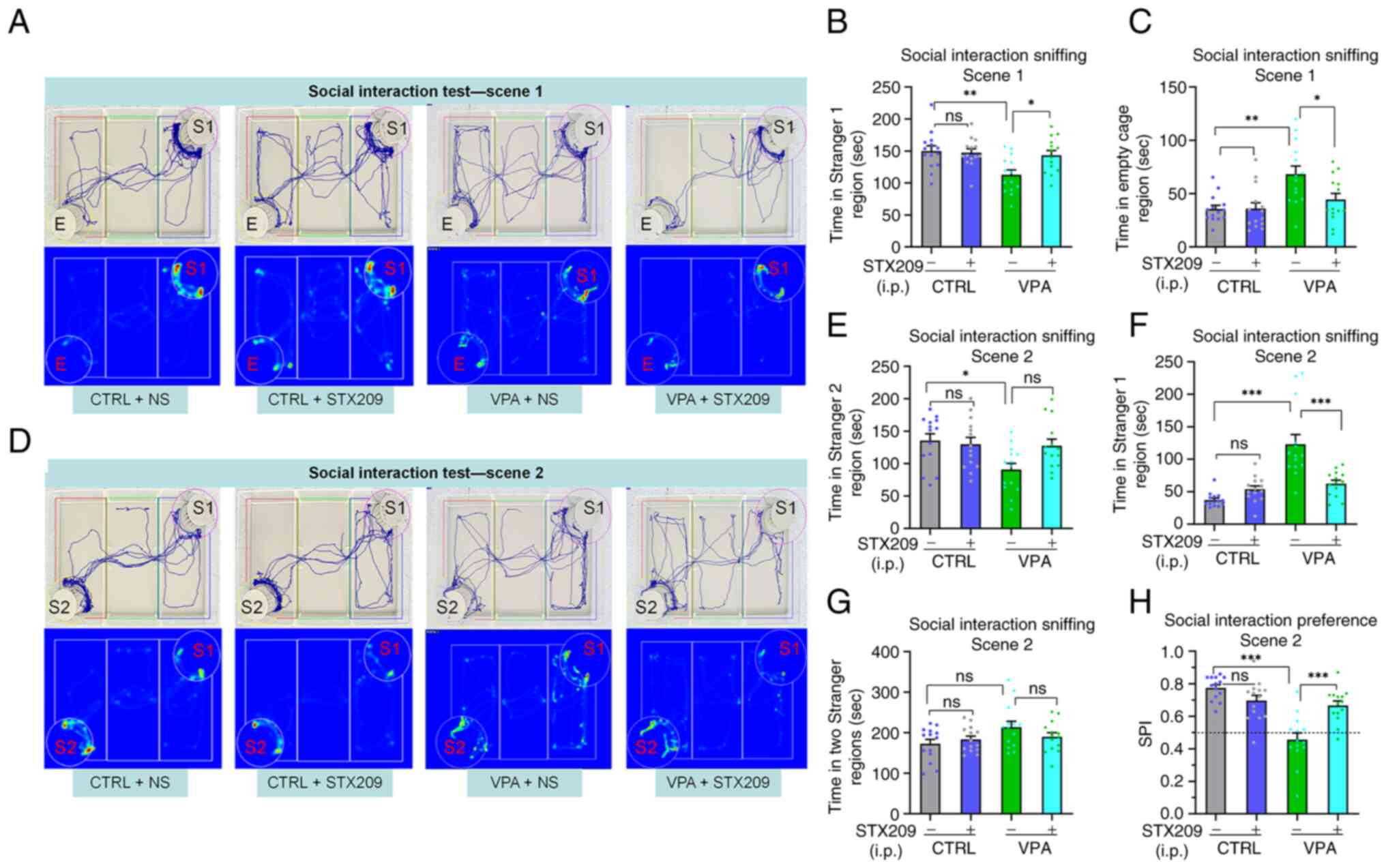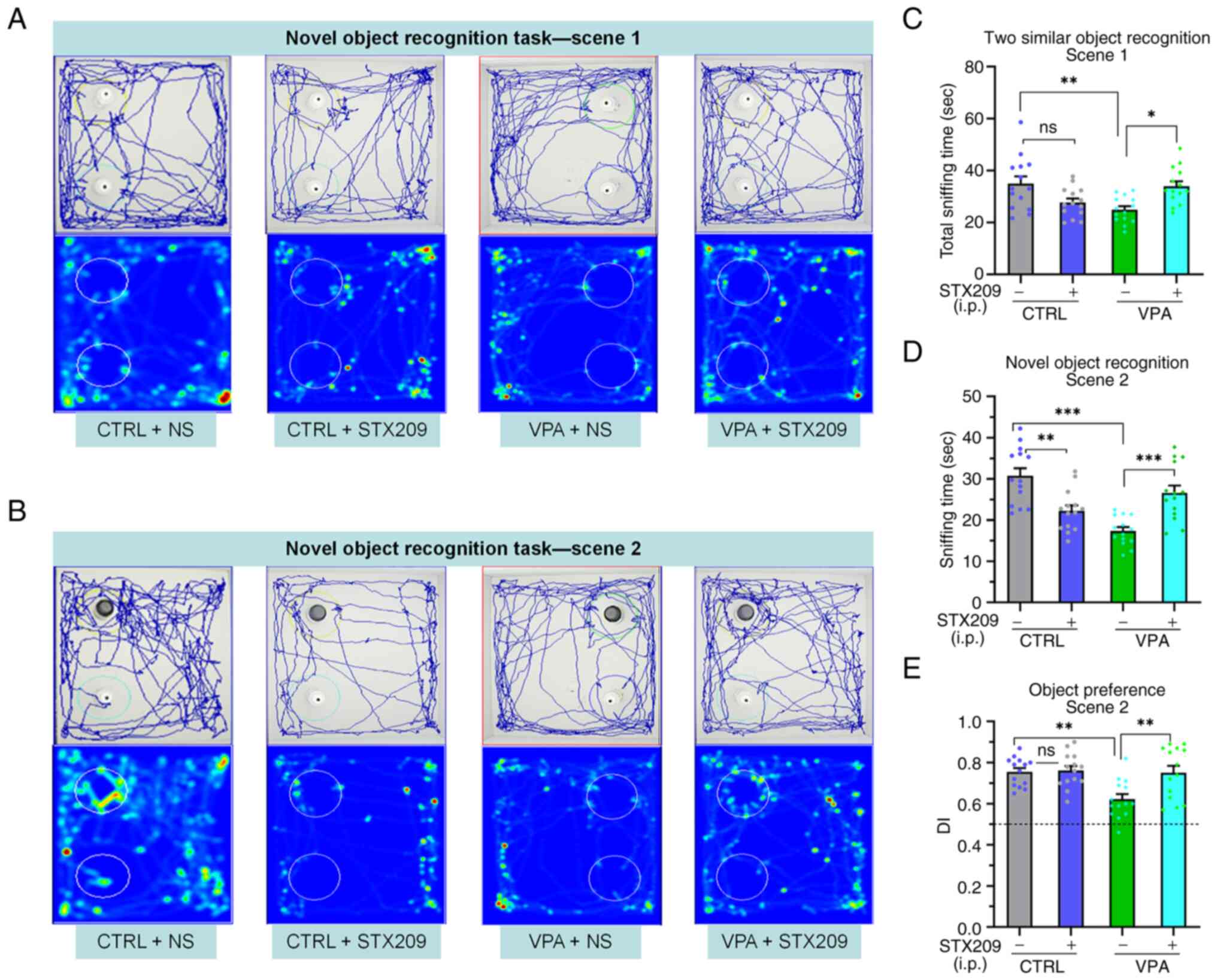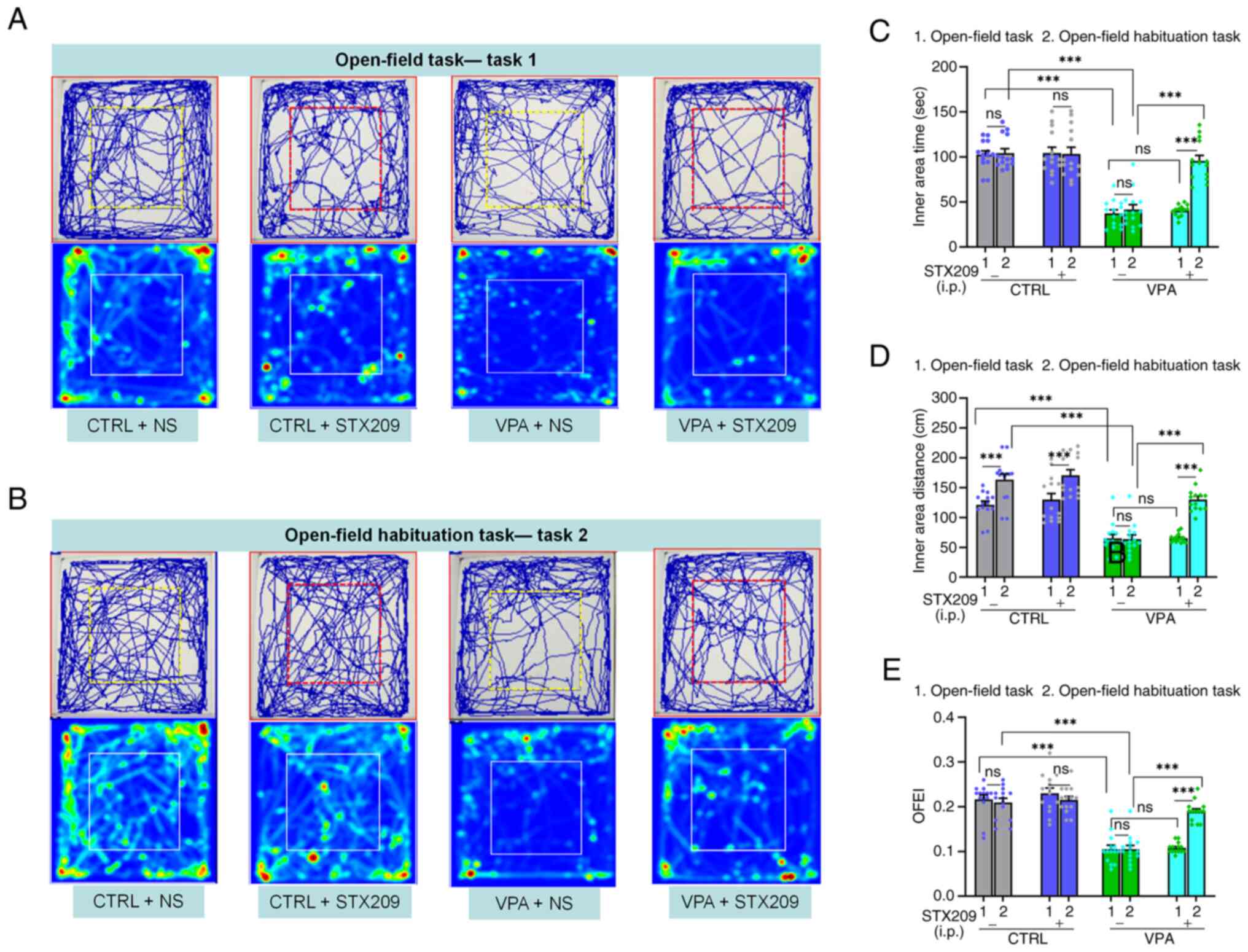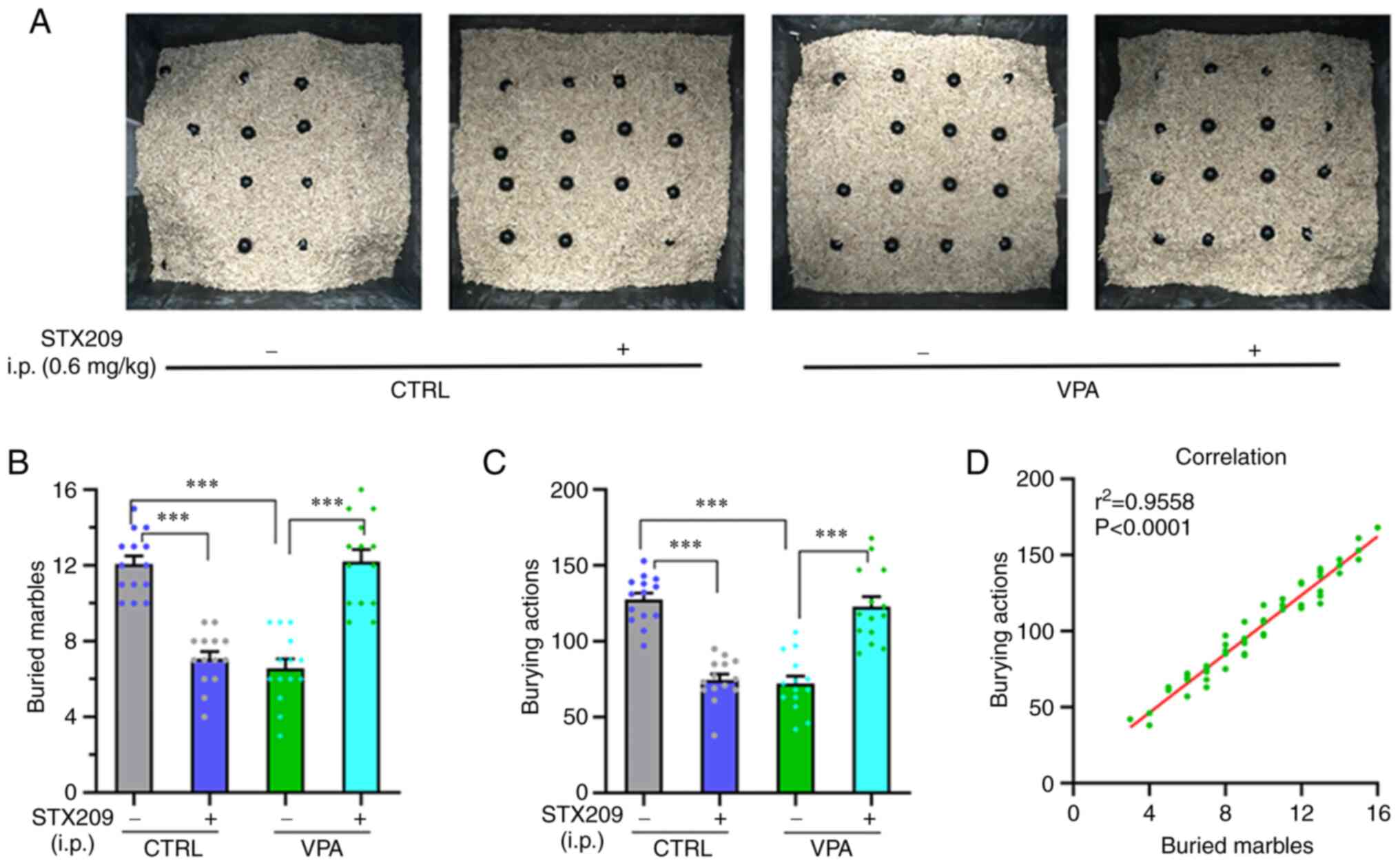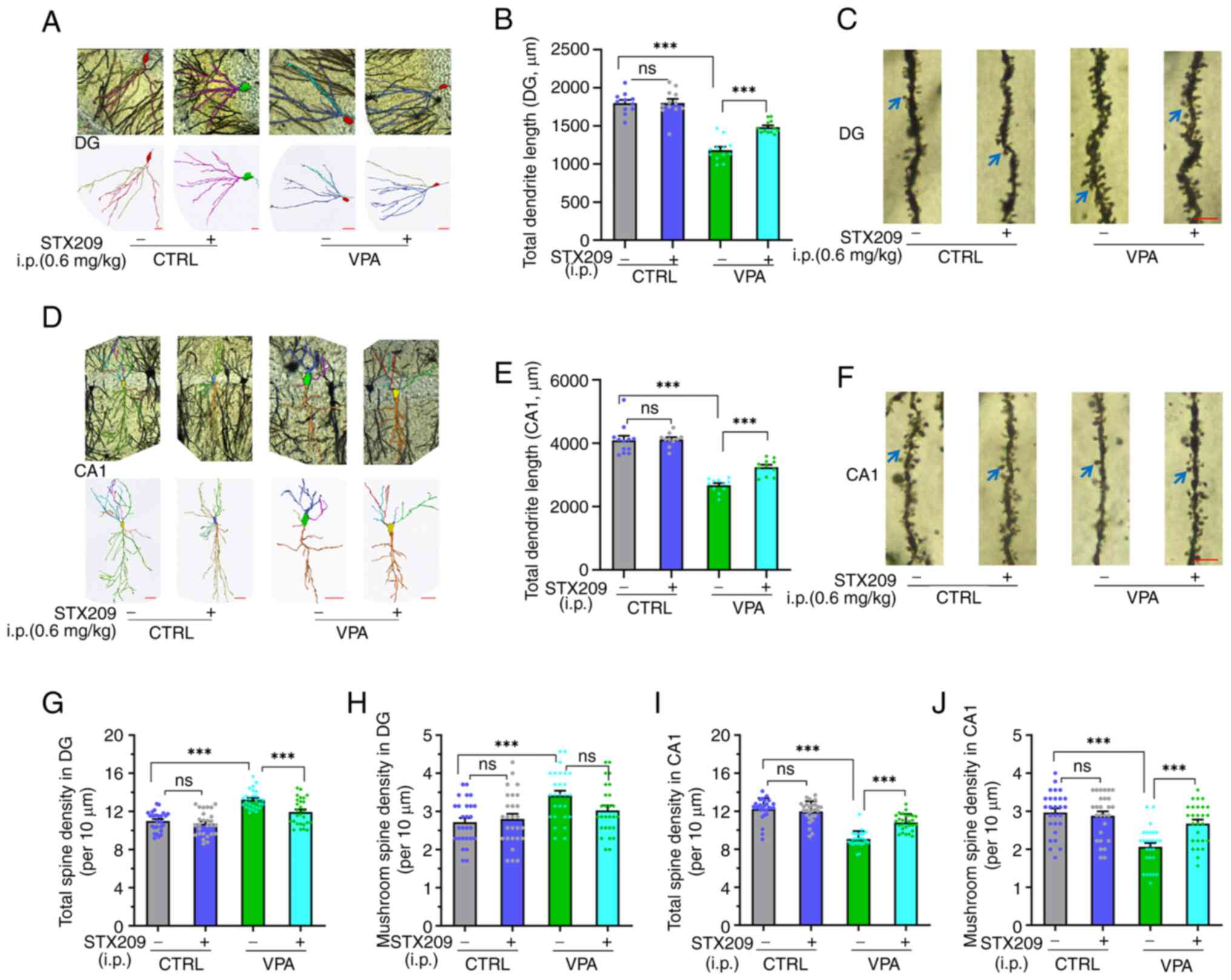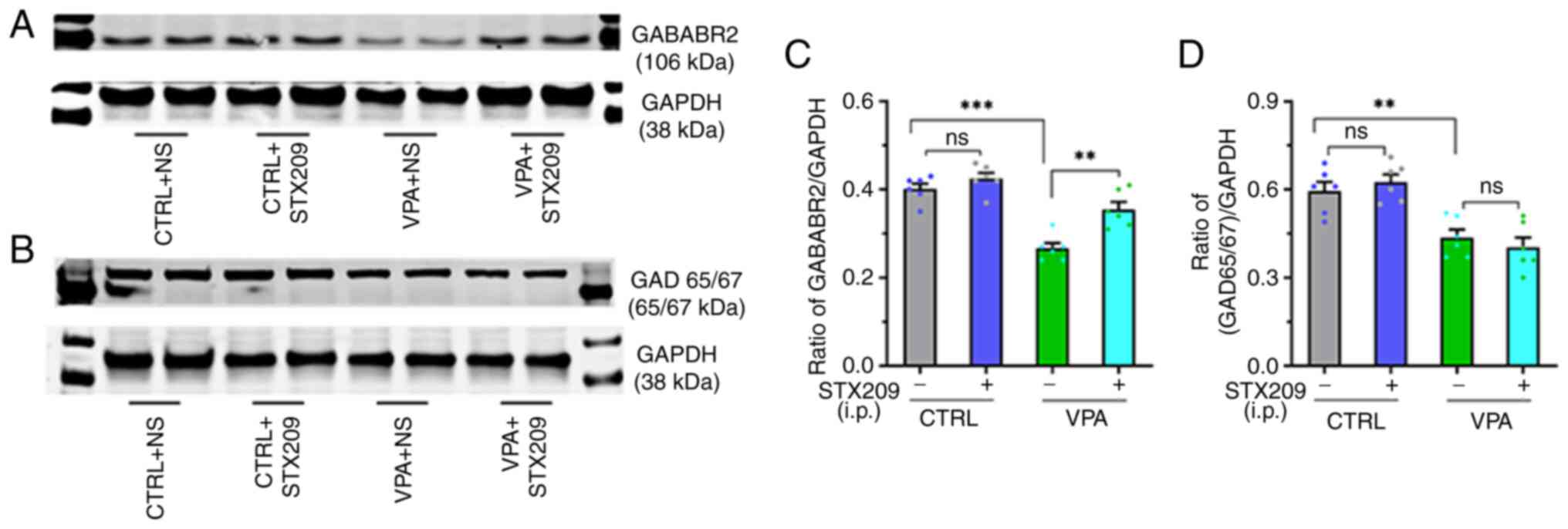|
1
|
American Psychiatric Association:
Diagnostic and statistical manual of mental disorders:
DSM-5™. (5th edition). American Psychiatric Publushing;
Washington, DC: 2013, View Article : Google Scholar
|
|
2
|
Volkmar FR, Woodbury-Smith M, Macari SL
and Øien RA: Seeing the forest and the trees: Disentangling autism
phenotypes in the age of DSM-5. Dev Psychopathol. 33:625–633. 2021.
View Article : Google Scholar : PubMed/NCBI
|
|
3
|
Christensen DL, Maenner MJ, Bilder D,
Constantino JN, Daniels J, Durkin MS, Fitzgerald RT,
Kurzius-Spencer M, Pettygrove SD, Robinson C, et al: Prevalence and
characteristics of autism spectrum disorder among children aged 4
years-early autism and developmental disabilities monitoring
network, seven sites, United States, 2010, 2012, and 2014. MMWR
Surveill Summ. 68:1–19. 2019. View Article : Google Scholar : PubMed/NCBI
|
|
4
|
Servadio M, Vanderschuren LJ and Trezza V:
Modeling autism-relevant behavioral phenotypes in rats and mice: Do
‘autistic’ rodents exist? Behav Pharmacol. 26:522–540. 2015.
View Article : Google Scholar : PubMed/NCBI
|
|
5
|
Roullet FI, Lai JK and Foster JA: In utero
exposure to valproic acid and autism-a current review of clinical
and animal studies. Neurotoxicol Teratol. 36:47–56. 2013.
View Article : Google Scholar : PubMed/NCBI
|
|
6
|
Taleb A, Lin W, Xu X, Zhang G, Zhou QG,
Naveed M, Meng F, Fukunaga K and Han F: Emerging mechanisms of
valproic acid-induced neurotoxic events in autism and its
implications for pharmacological treatment. Biomed Pharmacother.
137:1113222021. View Article : Google Scholar : PubMed/NCBI
|
|
7
|
Chaste P and Leboyer M: Autism risk
factors: Genes, environment, and gene-environment interactions.
Dialogues Clin Neurosci. 14:281–292. 2012. View Article : Google Scholar : PubMed/NCBI
|
|
8
|
Tartaglione AM, Schiavi S, Calamandrei G
and Trezza V: Prenatal valproate in rodents as a tool to understand
the neural underpinnings of social dysfunctions in autism spectrum
disorder. Neuropharmacology. 159:1074772019. View Article : Google Scholar : PubMed/NCBI
|
|
9
|
Nicolini C and Fahnestock M: The valproic
acid-induced rodent model of autism. Exp Neurol. 299:217–227. 2018.
View Article : Google Scholar : PubMed/NCBI
|
|
10
|
Schneider T, Roman A, Basta-Kaim A, Kubera
M, Budziszewska B, Schneider K and Przewłocki R: Gender-specific
behavioral and immunological alterations in an animal model of
autism induced by prenatal exposure to valproic acid.
Psychoneuroendocrinology. 33:728–740. 2008. View Article : Google Scholar : PubMed/NCBI
|
|
11
|
McPheeters ML, Warren Z, Sathe N, Bruzek
JL, Krishnaswami S, Jerome RN and Veenstra-Vanderweele J: A
systematic review of medical treatments for children with autism
spectrum disorders. Pediatrics. 127:e1312–e1321. 2011. View Article : Google Scholar : PubMed/NCBI
|
|
12
|
Owen R, Sikich L, Marcus RN, Corey-Lisle
P, Manos G, McQuade RD, Carson WH and Findling RL: Aripiprazole in
the treatment of irritability in children and adolescents with
autistic disorder. Pediatrics. 124:1533–1540. 2009. View Article : Google Scholar : PubMed/NCBI
|
|
13
|
Eissa N, Al-Houqani M, Sadeq A, Ojha SK,
Sasse A and Sadek B: Current enlightenment about etiology and
pharmacological treatment of autism spectrum disorder. Front
Neurosci. 12:3042018. View Article : Google Scholar : PubMed/NCBI
|
|
14
|
Canitano R: New experimental treatments
for core social domain in autism spectrum disorders. Front Pediatr.
2:612014. View Article : Google Scholar : PubMed/NCBI
|
|
15
|
Hashemi E, Ariza J, Rogers H, Noctor SC
and Martínez-Cerdeño V: The number of parvalbumin-expressing
interneurons is decreased in the prefrontal cortex in autism. Cereb
Cortex. 27:1931–1943. 2017.PubMed/NCBI
|
|
16
|
Ariza J, Rogers H, Hashemi E, Noctor SC
and Martínez-Cerdeño V: The number of chandelier and basket cells
are differentially decreased in prefrontal cortex in autism. Cereb
Cortex. 28:411–420. 2018. View Article : Google Scholar : PubMed/NCBI
|
|
17
|
Fatemi SH, Folsom TD, Reutiman TJ and
Thuras PD: Expression of GABA(B) receptors is altered in brains of
subjects with autism. Cerebellum. 8:64–69. 2009. View Article : Google Scholar : PubMed/NCBI
|
|
18
|
Fatemi SH, Folsom TD and Thuras PD:
Deficits in GABA(B) receptor system in schizophrenia and mood
disorders: A postmortem study. Schizophr Res. 128:37–43. 2011.
View Article : Google Scholar : PubMed/NCBI
|
|
19
|
Fatemi SH, Halt AR, Stary JM, Kanodia R,
Schulz SC and Realmuto GR: Glutamic acid decarboxylase 65 and 67
kDa proteins are reduced in autistic parietal and cerebellar
cortices. Biol Psychiatry. 52:805–810. 2002. View Article : Google Scholar : PubMed/NCBI
|
|
20
|
Oblak AL, Gibbs TT and Blatt GJ: Reduced
GABAA receptors and benzodiazepine binding sites in the posterior
cingulate cortex and fusiform gyrus in autism. Brain Res.
1380:218–228. 2011. View Article : Google Scholar : PubMed/NCBI
|
|
21
|
Oblak AL, Gibbs TT and Blatt GJ: Decreased
GABA(B) receptors in the cingulate cortex and fusiform gyrus in
autism. J Neurochem. 114:1414–1423. 2010.PubMed/NCBI
|
|
22
|
Han S, Tai C, Westenbroek RE, Yu FH, Cheah
CS, Potter GB, Rubenstein JL, Scheuer T, de la Iglesia HO and
Catterall WA: Autistic-like behaviour in Scn1a+/-mice and rescue by
enhanced GABA-mediated neurotransmission. Nature. 489:385–390.
2012. View Article : Google Scholar : PubMed/NCBI
|
|
23
|
Lee E, Lee J and Kim E:
Excitation/inhibition imbalance in animal models of autism spectrum
disorders. Biol Psychiatry. 81:838–347. 2017. View Article : Google Scholar : PubMed/NCBI
|
|
24
|
Hou Q, Wang Y, Li Y, Chen D, Yang F and
Wang S: A developmental study of abnormal behaviors and altered
GABAergic signaling in the VPA-treated rat model of autism. Front
Behav Neurosci. 12:1822018. View Article : Google Scholar : PubMed/NCBI
|
|
25
|
Banerjee A, García-Oscos F, Roychowdhury
S, Galindo LC, Hall S, Kilgard MP and Atzori M: Impairment of
cortical GABAergic synaptic transmission in an environmental rat
model of autism. Int J Neuropsychopharmacol. 16:1309–1318. 2013.
View Article : Google Scholar : PubMed/NCBI
|
|
26
|
Chau DK, Choi AY, Yang W, Leung WN and
Chan CW: Downregulation of glutamatergic and GABAergic proteins in
valproric acid associated social impairment during adolescence in
mice. Behav Brain Res. 316:255–260. 2017. View Article : Google Scholar : PubMed/NCBI
|
|
27
|
Rinaldi T, Silberberg G and Markram H:
Hyperconnectivity of local neocortical microcircuitry induced by
prenatal exposure to valproic acid. Cereb Cortex. 18:763–770. 2008.
View Article : Google Scholar : PubMed/NCBI
|
|
28
|
Rinaldi T, Perrodin C and Markram H:
Hyper-connectivity and hyper-plasticity in the medial prefrontal
cortex in the valproic acid animal model of autism. Front Neural
Circuits. 2:42008. View Article : Google Scholar : PubMed/NCBI
|
|
29
|
Lenart J, Augustyniak J, Lazarewicz JW and
Zieminska E: Altered expression of glutamatergic and GABAergic
genes in the valproic acid-induced rat model of autism: A screening
test. Toxicology. 440:1525002020. View Article : Google Scholar : PubMed/NCBI
|
|
30
|
Norton SA, Gifford JJ, Pawlak AP, Derbaly
A, Sherman SL, Zhang H, Wagner GC and Kusnecov AW: Long-lasting
behavioral and neuroanatomical effects of postnatal valproic acid
treatment. Neuroscience. 434:8–21. 2020. View Article : Google Scholar : PubMed/NCBI
|
|
31
|
Schiavi S, Iezzi D, Manduca A, Leone S,
Melancia F, Carbone C, Petrella M, Mannaioni G, Masi A and Trezza
V: Reward-related behavioral, neurochemical and
electrophysiological changes in a rat model of autism based on
prenatal exposure to valproic acid. Front Cell Neurosci.
13:4792019. View Article : Google Scholar : PubMed/NCBI
|
|
32
|
Crawley JN: Translational animal models of
autism and neurodevelopmental disorders. Dialogues Clin Neurosci.
14:293–305. 2012. View Article : Google Scholar : PubMed/NCBI
|
|
33
|
Bringas ME, Carvajal-Flores FN,
López-Ramírez TA, Atzori M and Flores G: Rearrangement of the
dendritic morphology in limbic regions and altered exploratory
behavior in a rat model of autism spectrum disorder. Neuroscience.
241:170–187. 2013. View Article : Google Scholar : PubMed/NCBI
|
|
34
|
Lal R, Sukbuntherng J, Tai EH, Upadhyay S,
Yao F, Warren MS, Luo W, Bu L, Nguyen S, Zamora J, et al:
Arbaclofen placarbil, a novel R-baclofen prodrug: Improved
absorption, distribution, metabolism, and elimination properties
compared with R-baclofen. J Pharmacol Exp Ther. 330:911–921. 2009.
View Article : Google Scholar : PubMed/NCBI
|
|
35
|
Sanchez-Ponce R, Wang LQ, Lu W, von Hehn
J, Cherubini M and Rush R: Metabolic and pharmacokinetic
differentiation of STX209 and racemic baclofen in humans.
Metabolites. 2:596–613. 2012. View Article : Google Scholar : PubMed/NCBI
|
|
36
|
Henderson C, Wijetunge L, Kinoshita MN,
Shumway M, Hammond RS, Postma FR, Brynczka C, Rush R, Thomas A,
Paylor R, et al: Reversal of disease-related pathologies in the
fragile X mouse model by selective activation of GABAB receptors
with arbaclofen. Sci Transl Med. 4:152ra1282012. View Article : Google Scholar : PubMed/NCBI
|
|
37
|
Silverman JL, Pride MC, Hayes JE, Puhger
KR, Butler-Struben HM, Baker S and Crawley JN: GABAB receptor
agonist R-baclofen reverses social deficits and reduces repetitive
behavior in two mouse models of autism. Neuropsychopharmacology.
40:2228–2239. 2015. View Article : Google Scholar : PubMed/NCBI
|
|
38
|
Qin M, Huang T, Kader M, Krych L, Xia Z,
Burlin T, Zeidler Z, Zhao T and Smith CB: R-baclofen reverses a
social behavior deficit and elevated protein synthesis in a mouse
model of fragile X syndrome. Int J Neuropsychopharmacol.
18:pyv0342015. View Article : Google Scholar : PubMed/NCBI
|
|
39
|
Sinclair D, Featherstone R, Naschek M, Nam
J, Du A, Wright S, Pance K, Melnychenko O, Weger R, Akuzawa S, et
al: GABA-B agonist baclofen normalizes auditory-evoked neural
oscillations and behavioral deficits in the Fmr1 knockout mouse
model of fragile X syndrome. eNeuro. 4:ENEURO.0380–16.2017. 2017.
View Article : Google Scholar : PubMed/NCBI
|
|
40
|
Stoppel LJ, Kazdoba TM, Schaffler MD,
Preza AR, Heynen A, Crawley JN and Bear MF: R-baclofen reverses
cognitive deficits and improves social interactions in two lines of
16p11.2 deletion mice. Neuropsychopharmacology. 43:513–524. 2018.
View Article : Google Scholar : PubMed/NCBI
|
|
41
|
Pacey LK, Tharmalingam S and Hampson DR:
Subchronic administration and combination metabotropic glutamate
and GABAB receptor drug therapy in fragile X syndrome. J Pharmacol
Exp Ther. 338:897–905. 2011. View Article : Google Scholar : PubMed/NCBI
|
|
42
|
Berry-Kravis EM, Hessl D, Rathmell B,
Zarevics P, Cherubini M, Walton-Bowen K, Mu Y, Nguyen DV,
Gonzalez-Heydrich J, Wang PP, et al: Effects of STX209 (arbaclofen)
on neurobehavioral function in children and adults with fragile X
syndrome: A randomized, controlled, phase 2 trial. Sci Transl Med.
4:152ra1272012. View Article : Google Scholar : PubMed/NCBI
|
|
43
|
Erickson CA, Veenstra-Vanderweele JM,
Melmed RD, McCracken JT, Ginsberg LD, Sikich L, Scahill L,
Cherubini M, Zarevics P, Walton-Bowen K, et al: STX209 (arbaclofen)
for autism spectrum disorders: An 8-week open-label study. J Autism
Dev Disord. 44:958–964. 2014. View Article : Google Scholar : PubMed/NCBI
|
|
44
|
Veenstra-VanderWeele J, Cook EH, King BH,
Zarevics P, Cherubini M, Walton-Bowen K, Bear MF, Wang PP and
Carpenter RL: Arbaclofen in children and adolescents with autism
spectrum disorder: A randomized, controlled, phase 2 trial.
Neuropsychopharmacology. 42:1390–1398. 2017. View Article : Google Scholar : PubMed/NCBI
|
|
45
|
Frye RE: Clinical potential, safety, and
tolerability of arbaclofen in the treatment of autism spectrum
disorder. Drug Healthc Patient Saf. 6:69–76. 2014. View Article : Google Scholar : PubMed/NCBI
|
|
46
|
Berry-Kravis E, Hagerman R, Visootsak J,
Budimirovic D, Kaufmann WE, Cherubini M, Zarevics P, Walton-Bowen
K, Wang P, Bear MF and Carpenter RL: Arbaclofen in fragile X
syndrome: Results of phase 3 trials. J Neurodev Disord. 9:32017.
View Article : Google Scholar : PubMed/NCBI
|
|
47
|
Boivin GP, Hickman DL, Creamer-Hente MA,
Pritchett-Corning KR and Bratcher NA: Review of CO2 as a
euthanasia agent for laboratory rats and mice. J Am Assoc Lab Anim
Sci. 56:491–499. 2017.PubMed/NCBI
|
|
48
|
American Veterinary Medical Association, .
AVMA guidelines for the Euthanasia of animals. 2020 edition.
2020
|
|
49
|
Zheng W, Hu Y, Chen D, Li Y and Wang S:
Improvement of a mouse model of valproic acid-induced autism. Nan
Fang Yi Ke Da Xue Xue Bao. 39:718–723. 2019.(In Chinese).
PubMed/NCBI
|
|
50
|
Choi CS, Gonzales EL, Kim KC, Yang SM, Kim
JW, Mabunga DF, Cheong JH, Han SH, Bahn GH and Shin CY: The
transgenerational inheritance of autism-like phenotypes in mice
exposed to valproic acid during pregnancy. Sci Rep. 6:362502016.
View Article : Google Scholar : PubMed/NCBI
|
|
51
|
Kazlauskas N, Seiffe A, Campolongo M,
Zappala C and Depino AM: Sex-specific effects of prenatal valproic
acid exposure on sociability and neuroinflammation: Relevance for
susceptibility and resilience in autism. Psychoneuroendocrinology.
110:1044412019. View Article : Google Scholar : PubMed/NCBI
|
|
52
|
Jiménez JA and Zylka MJ: Controlling
litter effects to enhance rigor and reproducibility with rodent
models of neurodevelopmental disorders. J Neurodev Disord.
13:22021. View Article : Google Scholar : PubMed/NCBI
|
|
53
|
Wang R, Tan J, Guo J, Zheng Y, Han Q, So
KF, Yu J and Zhang L: Aberrant development and synaptic
transmission of cerebellar cortex in a VPA induced mouse autism
model. Front Cell Neurosci. 12:5002018. View Article : Google Scholar : PubMed/NCBI
|
|
54
|
Heyser CJ: Assessment of developmental
milestones in rodents. Curr Protoc Neurosci. Chapter 8: Unit 8.18.
2004.PubMed/NCBI
|
|
55
|
Antunes M and Biala G: The novel object
recognition memory: neurobiology, test procedure, and its
modifications. Cogn Process. 13:93–110. 2012. View Article : Google Scholar : PubMed/NCBI
|
|
56
|
Modabbernia A, Velthorst E and Reichenberg
A: Environmental risk factors for autism: An evidence-based review
of systematic reviews and meta-analyses. Mol Autism. 8:132017.
View Article : Google Scholar : PubMed/NCBI
|
|
57
|
Binkerd PE, Rowland JM, Nau H and
Hendrickx AG: Evaluation of valproic acid (VPA) developmental
toxicity and pharmacokinetics in Sprague-Dawley rats. Fundam Appl
Toxicol. 11:485–493. 1988. View Article : Google Scholar : PubMed/NCBI
|
|
58
|
Yang M, Silverman JL and Crawley JN:
Automated three-chambered social approach task for mice. Curr
Protoc Neurosci. Chapter 8: Unit 8.26. 2011. View Article : Google Scholar : PubMed/NCBI
|
|
59
|
Rein B, Ma K and Yan Z: A standardized
social preference protocol for measuring social deficits in mouse
models of autism. Nat Protoc. 15:3464–3477. 2020. View Article : Google Scholar : PubMed/NCBI
|
|
60
|
Kim KC, Kim P, Go HS, Choi CS, Yang SI,
Cheong JH, Shin CY and Ko KH: The critical period of valproate
exposure to induce autistic symptoms in Sprague-Dawley rats.
Toxicol Lett. 201:137–142. 2011. View Article : Google Scholar : PubMed/NCBI
|
|
61
|
Dallas T, Pinel JP and Fibiger HC:
Conditioned defensive burying: A new paradigm for the study of
anxiolytic agents. Pharmacol Biochem Behav. 15:619–626. 1981.
View Article : Google Scholar : PubMed/NCBI
|
|
62
|
Kung'u N and Handley SL: Evaluation of
marble-burying behavior as a model of anxiety. Pharmacol Biochem
Behav. 38:63–67. 1991. View Article : Google Scholar : PubMed/NCBI
|
|
63
|
Langer E, Einat H and Stukalin Y:
Similarities and dissimilarities in the effects of benzodiazepines
and specific serotonin reuptake inhibitors (SSRIs) in the defensive
marble burying test: A systematic review and meta-analysis. Eur
Neuropsychopharmacol. 36:38–49. 2020. View Article : Google Scholar : PubMed/NCBI
|
|
64
|
Yamaguchi H, Hara Y, Ago Y, Takano E,
Hasebe S, Nakazawa T, Hashimoto H, Matsuda T and Takuma K:
Environmental enrichment attenuates behavioral abnormalities in
valproic acid-exposed autism model mice. Behav Brain Res.
333:67–73. 2017. View Article : Google Scholar : PubMed/NCBI
|
|
65
|
Hara Y, Ago Y, Taruta A, Katashiba K,
Hasebe S, Takano E, Onaka Y, Hashimoto H, Matsuda T and Takuma K:
Improvement by methylphenidate and atomoxetine of social
interaction deficits and recognition memory impairment in a mouse
model of valproic acid-induced autism. Autism Res. 9:926–939. 2016.
View Article : Google Scholar : PubMed/NCBI
|
|
66
|
Stepan J, Dine J and Eder M: Functional
optical probing of the hippocampal trisynaptic circuit in vitro:
Network dynamics, filter properties, and polysynaptic induction of
CA1 LTP. Front Neurosci. 9:1602015. View Article : Google Scholar : PubMed/NCBI
|
|
67
|
Naber PA, Witter MP and Lopes Silva FH:
Networks of the hippocampal memory system of the rat. The pivotal
role of the subiculum. Ann N Y Acad Sci. 911:392–403. 2000.
View Article : Google Scholar : PubMed/NCBI
|
|
68
|
Gandal MJ, Sisti J, Klook K, Ortinski PI,
Leitman V, Liang Y, Thieu T, Anderson R, Pierce RC, Jonak G, et al:
GABAB-mediated rescue of altered excitatory-inhibitory balance,
gamma synchrony and behavioral deficits following constitutive
NMDAR-hypofunction. Transl Psychiatry. 2:e1422012. View Article : Google Scholar : PubMed/NCBI
|
|
69
|
Lee B, Zhang Y, Kim Y, Kim S, Lee Y and
Han K: Age-dependent decrease of GAD65/67 mRNAs but normal
densities of GABAergic interneurons in the brain regions of
Shank3-overexpressing manic mouse model. Neurosci Lett. 649:48–54.
2017. View Article : Google Scholar : PubMed/NCBI
|
|
70
|
Ribak CE and Roberts RC: GABAergic
synapses in the brain identified with antisera to GABA and its
synthesizing enzyme, glutamate decarboxylase. J Electron Microsc
Tech. 15:34–48. 1990. View Article : Google Scholar : PubMed/NCBI
|
|
71
|
Gaiarsa JL and Porcher C: Emerging
neurotrophic role of GABAB receptors in neuronal circuit
development. Front Cell Neurosci. 7:2062013. View Article : Google Scholar : PubMed/NCBI
|
|
72
|
Heaney CF and Kinney JW: Role of GABA(B)
receptors in learning and memory and neurological disorders.
Neurosci Biobehav Rev. 63:1–28. 2016. View Article : Google Scholar : PubMed/NCBI
|















